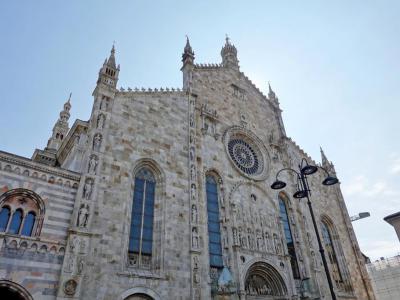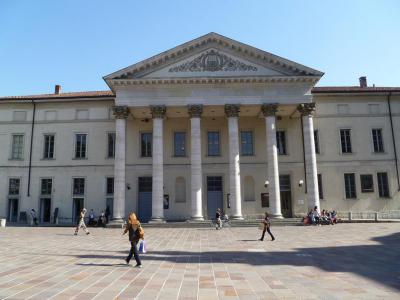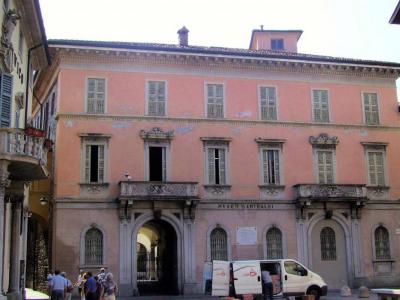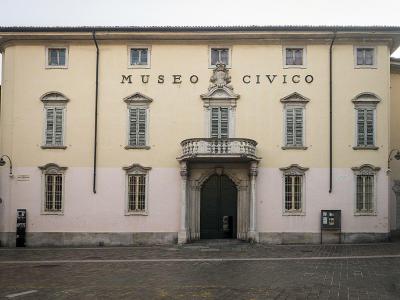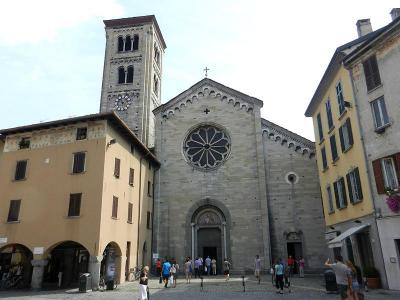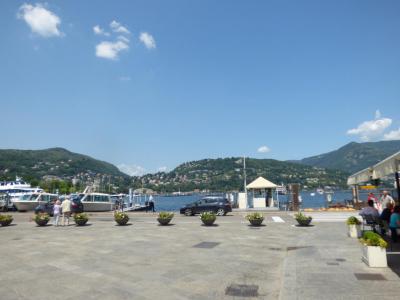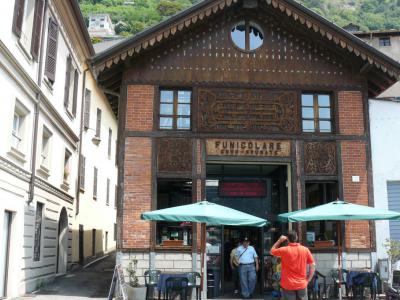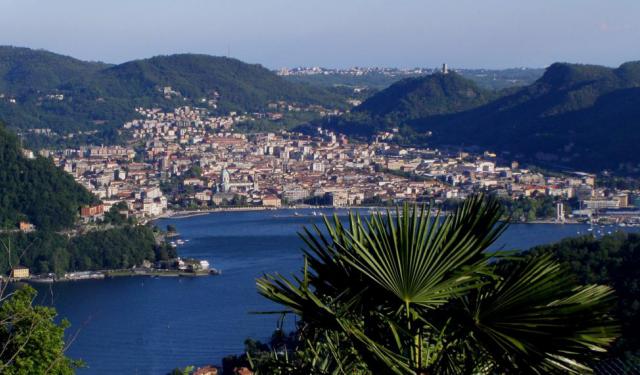
Como Introduction Walking Tour (Self Guided), Como
The Roman writer Pliny the Younger wrote to his friend, "What is the news from Como, mine and your delight?" Como is a place of churches, gardens, temples, museums, parks, and palaces. Its nearness to spectacular Lake Como and the Swiss and Italian Alps has made the area a travelers' delight from the time of Pliny the Younger until today.
In the 1st century BC, none other than Julius Caesar drained swamps, picked a site, and laid out the grid pattern of a Roman town. The walls of the Roman city, back then called Novum Comum, enclosed what is now the old Como city center. In 774 AD, the town became part of Charlemagne's empire.
It followed wars with Milan during 1127-1162, French invasions, Spanish dominion, pesky Austrians, and Napoleon. Then came Giuseppe Garibaldi and the Kingdom of Italy in 1859. It was not all Bread and Circuses. The Dictator Benito Mussolini had his day. He was executed by partisans after passing through Como in 1945.
Images of Pliny the Younger and his uncle Pliny the Elder adorn the facade of Como Cathedral, built in 1457. San Fedele, a Romanesque church, was erected in 1120. The Basilica of Saint Abbondio was consecrated in 1095. The Basilica of San Carpoforo is said to be using a former temple of the god Mercury. Cistercian Saint Agostino dates from the 1400s.
Secular buildings and monuments include the Old Town Hall. The House of Beams (Casa Dei Fascio), designed by futurist Giuseppe Terragni, is called "a landmark of modern European architecture." The imposing Monument to the Fallen is also a Terragni work.
Take a ride on the funicular to the mysterious Village of Bruneta. See the Lake from high above. Here is sparkling clear, alpine Lake Como, surrounded by forested mountains.
Come to enjoy Pliny's place of "delight."
In the 1st century BC, none other than Julius Caesar drained swamps, picked a site, and laid out the grid pattern of a Roman town. The walls of the Roman city, back then called Novum Comum, enclosed what is now the old Como city center. In 774 AD, the town became part of Charlemagne's empire.
It followed wars with Milan during 1127-1162, French invasions, Spanish dominion, pesky Austrians, and Napoleon. Then came Giuseppe Garibaldi and the Kingdom of Italy in 1859. It was not all Bread and Circuses. The Dictator Benito Mussolini had his day. He was executed by partisans after passing through Como in 1945.
Images of Pliny the Younger and his uncle Pliny the Elder adorn the facade of Como Cathedral, built in 1457. San Fedele, a Romanesque church, was erected in 1120. The Basilica of Saint Abbondio was consecrated in 1095. The Basilica of San Carpoforo is said to be using a former temple of the god Mercury. Cistercian Saint Agostino dates from the 1400s.
Secular buildings and monuments include the Old Town Hall. The House of Beams (Casa Dei Fascio), designed by futurist Giuseppe Terragni, is called "a landmark of modern European architecture." The imposing Monument to the Fallen is also a Terragni work.
Take a ride on the funicular to the mysterious Village of Bruneta. See the Lake from high above. Here is sparkling clear, alpine Lake Como, surrounded by forested mountains.
Come to enjoy Pliny's place of "delight."
How it works: Download the app "GPSmyCity: Walks in 1K+ Cities" from Apple App Store or Google Play Store to your mobile phone or tablet. The app turns your mobile device into a personal tour guide and its built-in GPS navigation functions guide you from one tour stop to next. The app works offline, so no data plan is needed when traveling abroad.
Como Introduction Walking Tour Map
Guide Name: Como Introduction Walking Tour
Guide Location: Italy » Como (See other walking tours in Como)
Guide Type: Self-guided Walking Tour (Sightseeing)
# of Attractions: 10
Tour Duration: 2 Hour(s)
Travel Distance: 2.6 Km or 1.6 Miles
Author: nataly
Sight(s) Featured in This Guide:
Guide Location: Italy » Como (See other walking tours in Como)
Guide Type: Self-guided Walking Tour (Sightseeing)
# of Attractions: 10
Tour Duration: 2 Hour(s)
Travel Distance: 2.6 Km or 1.6 Miles
Author: nataly
Sight(s) Featured in This Guide:
- Duomo di Como (Como Cathedral)
- Broletto di Como (Old Town Hall)
- Teatro Sociale (Social Theater)
- Terme di Como Romana (Roman Baths of Como)
- Museo Storico Giuseppe Garibaldi (Giuseppe Garibaldi History Museum)
- Museo Archeologico Paolo Giovio (Paolo Giovio Archaeological Museum)
- Basilica di San Fedele (Basilica of Saint Fidelis)
- Statua di Alessandro Volta (Statue of Alessandro Volta)
- Piazza Cavour (Cavour Square)
- Como–Brunate Funicular and Village of Brunate
1) Duomo di Como (Como Cathedral) (must see)
The reputably last Gothic cathedral built in Italy is the Como Cathedral (Duomo di Como), dedicated to the Assumption of the Blessed Virgin Mary. It dominates the vast Cathedral Square (Piazza Duomo) of Como City. Although considered Gothic, it has Romanesque, Renaissance, and Baroque architectural style elements.
Construction began in 1396. Architect Lorenzo degli Spazzi was in charge. An earlier Romanesque church was demolished to make way for the cathedral. The impressive facade was built in the latter half of the 15th century. Construction was finished in 1770, with the completion of the dome by architect Filippo Juvarra.
Features of the facade include a rose window over the central portal. Pliny the Elder and his nephew, Pliny the Younger, distinguished natives of Como, sit in glass-enclosed niches on either side of the entrance. The cases protect the statues from the damaging effects of smoke and smog.
The 286-foot-long and 246-foot-wide cathedral has a Latin Cross plan. There are three naves and a Renaissance transept topped by a stunning dome. Sculptures on the facade have both Gothic and Renaissance aspects. Two tondos over the portal depict Adam and Eve. Near the rose window is a statue of God, surrounded by other statues representing the archangel Gabriel, the Virgin Mary, and the Resurrection.
There are paintings of Saint Sebastian, Saint Christopher, and the Adoration of the Shepherds by Bernardino Luini and Marriage of the Virgin by Gaudenzio Ferrari. In the 16th and 17th centuries, the cathedral was decorated with tapestries from Florence, Ferrara, and Antwerp.
The north entrance to the cathedral is called the "door of the frog." The entryway has a sculpture dating from 1400 of a frog catching a butterfly. It's good luck to touch the frog. According to the local legend, Lake Como once flooded the town. The water stopped at the level of the frog. The people of Como say the frog saved the city.
Construction began in 1396. Architect Lorenzo degli Spazzi was in charge. An earlier Romanesque church was demolished to make way for the cathedral. The impressive facade was built in the latter half of the 15th century. Construction was finished in 1770, with the completion of the dome by architect Filippo Juvarra.
Features of the facade include a rose window over the central portal. Pliny the Elder and his nephew, Pliny the Younger, distinguished natives of Como, sit in glass-enclosed niches on either side of the entrance. The cases protect the statues from the damaging effects of smoke and smog.
The 286-foot-long and 246-foot-wide cathedral has a Latin Cross plan. There are three naves and a Renaissance transept topped by a stunning dome. Sculptures on the facade have both Gothic and Renaissance aspects. Two tondos over the portal depict Adam and Eve. Near the rose window is a statue of God, surrounded by other statues representing the archangel Gabriel, the Virgin Mary, and the Resurrection.
There are paintings of Saint Sebastian, Saint Christopher, and the Adoration of the Shepherds by Bernardino Luini and Marriage of the Virgin by Gaudenzio Ferrari. In the 16th and 17th centuries, the cathedral was decorated with tapestries from Florence, Ferrara, and Antwerp.
The north entrance to the cathedral is called the "door of the frog." The entryway has a sculpture dating from 1400 of a frog catching a butterfly. It's good luck to touch the frog. According to the local legend, Lake Como once flooded the town. The water stopped at the level of the frog. The people of Como say the frog saved the city.
2) Broletto di Como (Old Town Hall)
"Broletto" is an old term derived from the Medieval Latin word "brolo." A brolo was a broad, walled field where people could have town meetings. Eventually, the brolo or broletto became the Town Hall. Citizens used to gather in front of the municipal building, called by a bell, that was installed in the tower. In time, the Old Town Hall of Como was operated as a theatre and a communal archive. Today, it is a venue for exhibits and events.
The Old Town Hall, the ancient seat of the municipality of Como, is located on Vittorio Emanuele II Street, next to the Como Cathedral. It features a Gothic facade made with polychrome marble from local quarries and a civic tower made of rusticated stone. As written on the plaque on the main façade, just under the left window, the building was erected in 1215 at the behest of Bonardo da Cadazzo, mayor of Como.
The Old Town Hall style was a melange of Gothic-Romanesque-Renaissance elements. Parts of the facade date back to the 15th century. Over the centuries, the building underwent several modifications, in particular, to make room for the construction of the Como Cathedral. In the 20th century, the Old Town Hall returned to its original structure.
The Old Town Hall, the ancient seat of the municipality of Como, is located on Vittorio Emanuele II Street, next to the Como Cathedral. It features a Gothic facade made with polychrome marble from local quarries and a civic tower made of rusticated stone. As written on the plaque on the main façade, just under the left window, the building was erected in 1215 at the behest of Bonardo da Cadazzo, mayor of Como.
The Old Town Hall style was a melange of Gothic-Romanesque-Renaissance elements. Parts of the facade date back to the 15th century. Over the centuries, the building underwent several modifications, in particular, to make room for the construction of the Como Cathedral. In the 20th century, the Old Town Hall returned to its original structure.
3) Teatro Sociale (Social Theater)
The Social Theater (Teatro Sociale) of Como was founded following the decision of the local nobility that a new theatre was needed. It replaced the existing 1765-year building, which was regarded as outdated. The site of the ruined medieval castle, Round Tower (Torre Rotonda), was chosen as the location of the new theatre. Construction started under architect Giuseppe Cusi in early 1812 but was not finished until August 1813.
The new theatre had a Neo-classic facade, finished in time for a performance of Marco Portogallo's opera, "Adriano in Siria." Renovations done in 1854 created 38 new boxes. The theatre re-opened in 1855 with a box capacity of 98. By the early 20th century, the theatre was again determined to be too small to accommodate all who wished to attend. A new house was built in 1910.
The entrance portico is supported by six free-standing Corinthian columns. The facade has a regal, grand opera look. The cello-shaped auditorium has red velvet seats. On the ceiling painted by Eleuterio Pagliano, muses descend Olympus with crowns for artists. Curtains designed by Alessandro Sanquirico depict the volcanic death of Pliny the Elder.
Nicolo Paganini gave a virtuoso violin concert at the theatre in 1823. Franz Liszt performed his composition "The Serenade" and "The Orgy" there in 1837. The Social Theatre also has a famous outdoor stage called the "Arena." Closed in the 1960s, it re-opened in 2013 with a production of Carl Orff's "Carmina Burana."
Since 2012, every year in July, the entire city of Como is animated by the Como City of Music Festival (Festival Como Città della Musica) organized by the Social Theatre. Many international shows take place around the streets, from tango and swing ballets to African and Japanese traditional music concerts.
The new theatre had a Neo-classic facade, finished in time for a performance of Marco Portogallo's opera, "Adriano in Siria." Renovations done in 1854 created 38 new boxes. The theatre re-opened in 1855 with a box capacity of 98. By the early 20th century, the theatre was again determined to be too small to accommodate all who wished to attend. A new house was built in 1910.
The entrance portico is supported by six free-standing Corinthian columns. The facade has a regal, grand opera look. The cello-shaped auditorium has red velvet seats. On the ceiling painted by Eleuterio Pagliano, muses descend Olympus with crowns for artists. Curtains designed by Alessandro Sanquirico depict the volcanic death of Pliny the Elder.
Nicolo Paganini gave a virtuoso violin concert at the theatre in 1823. Franz Liszt performed his composition "The Serenade" and "The Orgy" there in 1837. The Social Theatre also has a famous outdoor stage called the "Arena." Closed in the 1960s, it re-opened in 2013 with a production of Carl Orff's "Carmina Burana."
Since 2012, every year in July, the entire city of Como is animated by the Como City of Music Festival (Festival Como Città della Musica) organized by the Social Theatre. Many international shows take place around the streets, from tango and swing ballets to African and Japanese traditional music concerts.
4) Terme di Como Romana (Roman Baths of Como)
Little did Pliny the Younger suspect that the thermal baths he donated to his native city of Como would turn up two thousand years later under a city parking lot. The parking lot is underground. The baths are underground. A small sign in the multi-story parking says "Roman Baths of Como."
The underground parking project was planned in the 70s. When work began, a bit of the bath complex was uncovered. A formal excavation proceeded along with the construction of the parking. The walls of eight rooms covering 1,500 square meters were unearthed. They were identified as originating from the 1st century AD.
In 2006 further excavation revealed ten more rooms dated from the 2nd century. They surround a central courtyard. Their functions are unknown. Visitors can see the archaeological ruins from the ground floor, which lies beneath the new parking garage or walk through the exhibit.
Two small showrooms with explanatory panels preserve artifacts discovered during excavations from 2006-2008. The archeological site, located at Lecco Avenue (Viale Lecco,) opens to the public on Tuesdays, Thursdays, and Saturdays; admission to the remains of Roman Baths is free.
The underground parking project was planned in the 70s. When work began, a bit of the bath complex was uncovered. A formal excavation proceeded along with the construction of the parking. The walls of eight rooms covering 1,500 square meters were unearthed. They were identified as originating from the 1st century AD.
In 2006 further excavation revealed ten more rooms dated from the 2nd century. They surround a central courtyard. Their functions are unknown. Visitors can see the archaeological ruins from the ground floor, which lies beneath the new parking garage or walk through the exhibit.
Two small showrooms with explanatory panels preserve artifacts discovered during excavations from 2006-2008. The archeological site, located at Lecco Avenue (Viale Lecco,) opens to the public on Tuesdays, Thursdays, and Saturdays; admission to the remains of Roman Baths is free.
5) Museo Storico Giuseppe Garibaldi (Giuseppe Garibaldi History Museum)
In May 1859, the general of the Roman Republic Giuseppe Garibaldi and his Hunters of the Alps, military corps, left the town of Varese and approached the mountain pass at San Fermo. They cornered the Austro-Hungarians at the church of San Fermo. Attacking from three sides, the Italians suffered 14 killed. Despite these losses, the Italians quickly routed the Austro-Hungarians.
Austrian General Urban launched counterattacks up the steep road from Como. They failed. The next day, as the Italians slowly descended into Como, they found that Urban and his forces had decamped, never to return. Items of interest relating to the Battle of San Fermo are now on display in the Giuseppe Garibaldi Museum in Como.
Located in the 15th-century Olginati Palace (Palazzo Olginati) in Como, the museum was established in 1932 to commemorate the 50th anniversary of Giuseppe Garibaldi's death. It is dedicated to general Garibaldi and his role in the Unification of Italy. Shortly after opening, it was joined to the Archaeological Museum in the Paolo Giovo building (palazzo Paolo Giovo) with two covered walkways. Together, they form the two "Civic Museums" of Como.
The museum mainly comprises two sections: the first is dedicated to the historical events of the Unification of Italy (Risorgimento), the main stages of Como and Italian history, from the first rebellions through the wars of independence, and the figure of Garibaldi. The second section includes fabrics, clothing items, furnishings, and other objects that document aspects of Italian life between the seventeenth and twentieth centuries.
Austrian General Urban launched counterattacks up the steep road from Como. They failed. The next day, as the Italians slowly descended into Como, they found that Urban and his forces had decamped, never to return. Items of interest relating to the Battle of San Fermo are now on display in the Giuseppe Garibaldi Museum in Como.
Located in the 15th-century Olginati Palace (Palazzo Olginati) in Como, the museum was established in 1932 to commemorate the 50th anniversary of Giuseppe Garibaldi's death. It is dedicated to general Garibaldi and his role in the Unification of Italy. Shortly after opening, it was joined to the Archaeological Museum in the Paolo Giovo building (palazzo Paolo Giovo) with two covered walkways. Together, they form the two "Civic Museums" of Como.
The museum mainly comprises two sections: the first is dedicated to the historical events of the Unification of Italy (Risorgimento), the main stages of Como and Italian history, from the first rebellions through the wars of independence, and the figure of Garibaldi. The second section includes fabrics, clothing items, furnishings, and other objects that document aspects of Italian life between the seventeenth and twentieth centuries.
6) Museo Archeologico Paolo Giovio (Paolo Giovio Archaeological Museum)
The Archeological Museum has been housed for over a century in the Paolo Giovio Palace, once the in-town residence of the noble Giovio family. Collections of ancient and medieval artifacts were moved to the historical building in the pedestrian area within the city walls in 1894. The property itself dates from the late Middle Ages.
A major renovation in the 16th century by Benedetto Giovio created the current Lombard Baroque appearance of the palace. In the 18th century, large windows were added to the facade, and a loggia was installed above the main entrance. Further changes were made to the stairway, the garden, and the nymphaeum (shrine).
Three halls on the first floor have frescoes by three different artists. "Perrone Hall" is decorated by Giovan Battista Rodriguez. "Barelli Hall" was done by Giuseppe Coduri. "Hall of the Wedding" has frescoes by Giovanni Battista Ronchelli. The Historical Museum was established in 1932, and the Art Gallery in 1989.
The building is bordered on the northeast by Gold Medals Square (Piazza Medaglie d'Oro). In the southeast, it touches the Olginati Palace. The two palaces are connected by an elevated walkway that crosses above Balestra street, a public road since 1930.
The Archeological Museum displays the history of Como, from Prehistory to the Middle Ages. The Museum itinerary is always up-to-date, showing new archaeological finds in the area. Furthermore, visitors will find a collectibles section with Egyptian, Greek, and Magna Graecia (Great Greece- a group of ancient Greek cities along the coast of southern Italy) finds, bronze statuettes, and gems. The museum also houses a vast library.
A major renovation in the 16th century by Benedetto Giovio created the current Lombard Baroque appearance of the palace. In the 18th century, large windows were added to the facade, and a loggia was installed above the main entrance. Further changes were made to the stairway, the garden, and the nymphaeum (shrine).
Three halls on the first floor have frescoes by three different artists. "Perrone Hall" is decorated by Giovan Battista Rodriguez. "Barelli Hall" was done by Giuseppe Coduri. "Hall of the Wedding" has frescoes by Giovanni Battista Ronchelli. The Historical Museum was established in 1932, and the Art Gallery in 1989.
The building is bordered on the northeast by Gold Medals Square (Piazza Medaglie d'Oro). In the southeast, it touches the Olginati Palace. The two palaces are connected by an elevated walkway that crosses above Balestra street, a public road since 1930.
The Archeological Museum displays the history of Como, from Prehistory to the Middle Ages. The Museum itinerary is always up-to-date, showing new archaeological finds in the area. Furthermore, visitors will find a collectibles section with Egyptian, Greek, and Magna Graecia (Great Greece- a group of ancient Greek cities along the coast of southern Italy) finds, bronze statuettes, and gems. The museum also houses a vast library.
7) Basilica di San Fedele (Basilica of Saint Fidelis) (must see)
Saint Fidelis, Carpophorus, and Exanthus are celebrated as saints and martyrs in Como. One story goes they were three soldiers bent on converting pagans around Como. All the stories end the same way; martyrdom in the reign of Diocletian.
The Basilica of Saint Fidelis is dedicated to this third-century martyr. The church, located in the San Fedele Square in the city center of Como, was erected in 1120 over a Christian church from the 7th century, dedicated to Saint Euphemia, also a martyr.
The building features a Romanesque architectural style. The ceiling is a barrel vault with a bone-arched pediment. The Neo-Romanesque facade has a central rose window. The front was rebuilt by architect Antonio Giussani in 1914. The square-sided bell tower, erected in 1120, was rebuilt in 1271 after an earthquake. It was demolished and rebuilt again in 1905.
The interior has three naves and three apses covered by a dome and bounded by an ambulatory with medieval votive frescoes. The Chapel of the Crucifix features a fresco painted on the apse by Isidoro Bianchi in 1623. The paintings contain God the Father, the risen Christ, saints, bishops, angels, and archangels.
In the south aisle, four paintings illustrate scenes of the Passion by painter and engraver Carlo Innocenzo Carloni. In the north aisle chapel, there are 17th-century frescoes of the life of the Virgin Mary and the Visit of the Magi. In another chapel is a 1504 triptych by painter Giovanni Andrea De Magistris of Madonna with Child.
The Basilica of Saint Fidelis is dedicated to this third-century martyr. The church, located in the San Fedele Square in the city center of Como, was erected in 1120 over a Christian church from the 7th century, dedicated to Saint Euphemia, also a martyr.
The building features a Romanesque architectural style. The ceiling is a barrel vault with a bone-arched pediment. The Neo-Romanesque facade has a central rose window. The front was rebuilt by architect Antonio Giussani in 1914. The square-sided bell tower, erected in 1120, was rebuilt in 1271 after an earthquake. It was demolished and rebuilt again in 1905.
The interior has three naves and three apses covered by a dome and bounded by an ambulatory with medieval votive frescoes. The Chapel of the Crucifix features a fresco painted on the apse by Isidoro Bianchi in 1623. The paintings contain God the Father, the risen Christ, saints, bishops, angels, and archangels.
In the south aisle, four paintings illustrate scenes of the Passion by painter and engraver Carlo Innocenzo Carloni. In the north aisle chapel, there are 17th-century frescoes of the life of the Virgin Mary and the Visit of the Magi. In another chapel is a 1504 triptych by painter Giovanni Andrea De Magistris of Madonna with Child.
8) Statua di Alessandro Volta (Statue of Alessandro Volta)
In 1780 Luigi Galvani was tickling frogs' legs with bits of metal. A minute electric current passing through the metals would make the legs twitch. Galvani and his supporters held that electricity was generated by animal tissue. Alessandro Volta of Como disagreed. He set about to prove the little sparks came from differing metals.
The upshot of all this was Volta's revolutionary invention, the Voltaic Pile, the first electrical battery. Volta proved that electricity is generated chemically. Volta's invention stimulated scientific excitement and led others to conduct similar experiments, which led to the development of the field of electrochemistry. The discovery made Volta famous, but he preferred a quiet life. He retired to his country house where he died at age 82.
The monument to Alessandro Volta was erected in Como in 1838. The statue of Volta was sculpted by renowned artist Pompeo Marchesi, while a massive base and pedestal are the work of Francesco Durelli. Volta stands atop the high pedestal in a toga (the loose outer garment worn in public by citizens of ancient Rome). His left-hand holds a book. The right-hand rests on the Voltaic Pile.
An inscription in Italian with Roman numerals on the monument base says "A VOLTA/A HOMELAND 1838 " ( "A VOLTA / A PATRIA/ A MDCCCXXXVIII"). Two bronze tablets in the monument flower bed cite the invention of the Voltaic Pile with the centennial date of 1899.
The upshot of all this was Volta's revolutionary invention, the Voltaic Pile, the first electrical battery. Volta proved that electricity is generated chemically. Volta's invention stimulated scientific excitement and led others to conduct similar experiments, which led to the development of the field of electrochemistry. The discovery made Volta famous, but he preferred a quiet life. He retired to his country house where he died at age 82.
The monument to Alessandro Volta was erected in Como in 1838. The statue of Volta was sculpted by renowned artist Pompeo Marchesi, while a massive base and pedestal are the work of Francesco Durelli. Volta stands atop the high pedestal in a toga (the loose outer garment worn in public by citizens of ancient Rome). His left-hand holds a book. The right-hand rests on the Voltaic Pile.
An inscription in Italian with Roman numerals on the monument base says "A VOLTA/A HOMELAND 1838 " ( "A VOLTA / A PATRIA/ A MDCCCXXXVIII"). Two bronze tablets in the monument flower bed cite the invention of the Voltaic Pile with the centennial date of 1899.
9) Piazza Cavour (Cavour Square) (must see)
Cavour Square is the main square of Como and the heart of the historical center of the city. It is a place to enjoy views of Lake Como and its surrounding hills. It is a perfect venue for people-watching, festivals, and cultural events.
In the Middle Ages, the square was swampy, undeveloped land. The area evolved into an urban public place in the 19th century. The north side of Cavour Square runs along the shores of Lake Como. Sit on one of the benches at the edge. Boats traverse the sparkling waters. In the distance, the Faro Voltiano lighthouse stands high in the forested hills.
The surrounding landmark buildings are worth some study. On the western edge is the 1846 Hotel Metropole Suisse. Multi-colored Italianate buildings on the east side house cafes, restaurants, and gelato parlors. Street performers are often seen here.
The square frequently hosts fairs, concerts, and markets. Enjoy the music from the '30s and '40s at the Swing Crash Festival in June. Visit in December for the Christmas Market. Browse the many stalls hunting up local artisan crafts and souvenirs.
The square is no more than a five-minute walk from the train station. It is easy to reach the Como Cathedral from Cavour Square. A walk along the waterfront will lead to the Funicular Como-Brunate. Take the mountain railway up to scenic Brunate village.
In the Middle Ages, the square was swampy, undeveloped land. The area evolved into an urban public place in the 19th century. The north side of Cavour Square runs along the shores of Lake Como. Sit on one of the benches at the edge. Boats traverse the sparkling waters. In the distance, the Faro Voltiano lighthouse stands high in the forested hills.
The surrounding landmark buildings are worth some study. On the western edge is the 1846 Hotel Metropole Suisse. Multi-colored Italianate buildings on the east side house cafes, restaurants, and gelato parlors. Street performers are often seen here.
The square frequently hosts fairs, concerts, and markets. Enjoy the music from the '30s and '40s at the Swing Crash Festival in June. Visit in December for the Christmas Market. Browse the many stalls hunting up local artisan crafts and souvenirs.
The square is no more than a five-minute walk from the train station. It is easy to reach the Como Cathedral from Cavour Square. A walk along the waterfront will lead to the Funicular Como-Brunate. Take the mountain railway up to scenic Brunate village.
10) Como–Brunate Funicular and Village of Brunate (must see)
Como-Brunate Funicular runs up and down between two towns, Brunate at the top and Como at the bottom. The line has operated since 1894. In August 2011, new cars, each 39 feet long with a passenger capacity of 81, were installed. The trip takes seven minutes at a max speed of 9.8 feet per second.
The lower station is located quayside near the Como city center. The line is 3,556 feet long; 427 feet long are in a tunnel. After leaving the tunnel, one has spectacular views of Como Lake and Como city. Two intermediate stops can be made if requested.
At the top of the line is the center of the picturesque village of Brunate. Brunate is small, ancient, and mysterious. It is the very stuff of stories and legends. A unique special attraction, of course, is the panoramic views of the city, the lake, and the Italian alps. Brunate is home to only 1,800 souls; all that changes radically in summer.
The main square of Brunate is the Church Square (Piazza Chiesa), dominated by the 14th-century Church of Saint Andrew the Apostle. Basically Romanesque, it has two facades, front and back, one ornate and one plain. The square bell tower has a belfry and a clock.
When leaving Church Square, visitors encounter the Church of San Maurizio, a bar, a restaurant, and a pizzeria. Above the Square is the City Park. Past the park is the Lighthouse Faro Voltiano, built in 1927 in memory of Alessandro Volta, a native of Como and inventor of the electric battery.
The Lighthouse has the legend of "Kangucavallo." Once upon a time, an exhausted family of four, including two small children, was struggling to reach the Lighthouse. The father prayed, "I need a kangaroo and horse to carry us up." Enter Kangucavallo, half horse, half kangaroo. The good-natured beast took the family up.
To this day, villagers say, Kangucavallo haunts the forest. He is very friendly, but one must not try to tame him. He has a mind of his own and appears only to the pure heart.
The lower station is located quayside near the Como city center. The line is 3,556 feet long; 427 feet long are in a tunnel. After leaving the tunnel, one has spectacular views of Como Lake and Como city. Two intermediate stops can be made if requested.
At the top of the line is the center of the picturesque village of Brunate. Brunate is small, ancient, and mysterious. It is the very stuff of stories and legends. A unique special attraction, of course, is the panoramic views of the city, the lake, and the Italian alps. Brunate is home to only 1,800 souls; all that changes radically in summer.
The main square of Brunate is the Church Square (Piazza Chiesa), dominated by the 14th-century Church of Saint Andrew the Apostle. Basically Romanesque, it has two facades, front and back, one ornate and one plain. The square bell tower has a belfry and a clock.
When leaving Church Square, visitors encounter the Church of San Maurizio, a bar, a restaurant, and a pizzeria. Above the Square is the City Park. Past the park is the Lighthouse Faro Voltiano, built in 1927 in memory of Alessandro Volta, a native of Como and inventor of the electric battery.
The Lighthouse has the legend of "Kangucavallo." Once upon a time, an exhausted family of four, including two small children, was struggling to reach the Lighthouse. The father prayed, "I need a kangaroo and horse to carry us up." Enter Kangucavallo, half horse, half kangaroo. The good-natured beast took the family up.
To this day, villagers say, Kangucavallo haunts the forest. He is very friendly, but one must not try to tame him. He has a mind of his own and appears only to the pure heart.
Walking Tours in Como, Italy
Create Your Own Walk in Como
Creating your own self-guided walk in Como is easy and fun. Choose the city attractions that you want to see and a walk route map will be created just for you. You can even set your hotel as the start point of the walk.
Como Lakeshore Walking Tour
English novelist Mary Shelley declared visitors to Italy are in danger of becoming: "enjoyers of the beauties of nature, the elegance of art, the delights of climate, the recollections of the past, and the pleasures of society." All this she found on the shores of Lake Como. From Roman writer Pliny the Younger onward, visitors and natives of Como would have agreed.
The alpine lake is... view more
Tour Duration: 1 Hour(s)
Travel Distance: 2.1 Km or 1.3 Miles
The alpine lake is... view more
Tour Duration: 1 Hour(s)
Travel Distance: 2.1 Km or 1.3 Miles
The Most Popular Cities
/ view all
